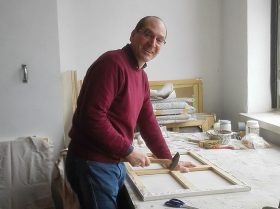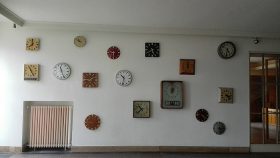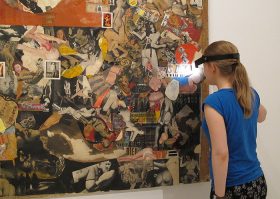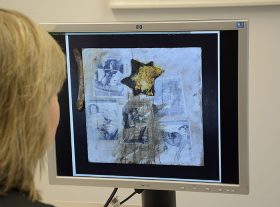Joachim Seinfeld’s HeimatReisen (HomelandTravels)

Joachim Seinfeld at work in his atelier in the former broadcasting station in Berlin; Jewish Museum Berlin, photo: Michaela Roßberg
The wonderful thing about Berlin for me as an historian is that there’s something around every corner waiting to wow me or get my “history heart” to skip a beat. I was able to get to know yet another spot this year when I interviewed Joachim Seinfeld in his atelier in the old broadcasting station in the Berlin Treptow-Köpenick district. We talked about his HeimatReisen (HomelandTravels) project for the art vending machine at the Jewish Museum Berlin (further information on the art vending machine on our website).

The station’s entryway was built with marble tiles from the New Reich Chancellery; Jewish Museum Berlin, photo: Michaela Roßberg
The broadcasting station on Nalepastrasse is a unique place: Beginning in 1956, programming across the former GDR was produced and broadcast from there. The public broadcasting system, established following German reunification, took over this work in 1991 and then, after several changes in ownership, the building became a place for artists from around the world to establish their ateliers.
Joachim, your photo series – available to visitors in the art vending machine – consists of a number of images depicting you in various locations around Germany. Why, of all your work, these images for the vending machine?
In 2006, I did a photo series about Poland. In 2011, I thought to do something similar about Germany. So I wanted to do it anyway, and I chose the images most interesting to me. → continue reading
Conservation Work on the Boris Lurie Exhibition

Conservator Alicija Steczek in front of a work of Boris Lurie; Jewish Museum Berlin, photo: Stephan Lohrengel
Visitors to our exhibition “No Compromises! The Art of Boris Lurie” (further information on our website) do not usually realize that they are viewing the result of lengthy groundwork and complex collaboration between various divisions of the museum. Those involved include, among others, employees of the temporary exhibition department, the registrars who for example take care of loans and organize shipments, and us conservators. We were already on board a year and a half before the exhibition was installed. Our work continues for the duration, only coming to an end with the closing and removal of the show in early August.
Boris Lurie’s art is fascinating and very variegated as to materials. Our work to protect it is thus correspondingly elaborate. → continue reading

Nina Wilkens contemplating the collage “Found objects on flat cardboard box” on her computer screen; Jewish Museum Berlin, photo: Svenja Kutscher
Five black and white photographs of a scantily-clad woman, legs spread open, in various suggestive poses. The pictures smudged and stuck askew onto white cardboard. On top, a Star of David partly smeared with yellow paint. A brown dildo is fastened next to the cardboard. This constellation of things looks at first glance like useless trash. Objects left on the ground, covered with their share of grime, and now lying here piled on top of one another. This work by Boris Lurie from our current exhibition “No Compromises! The Art of Boris Lurie” (further information about the exhibition on our website) has no name and its date is ambiguous.
When I started thinking, around a year ago, about a pedagogical program on Boris Lurie, I got stuck on this picture as I sat at my computer clicking through images of the works that were being considered for the exhibit. I was confused by my own reaction to this collage of two- and three-dimensional objects: vacillating between disgust and uncertainty. I had the words “obscene” and “tasteless” on the tip of my tongue but found them unsuitable. The image hurt. I wondered how students would react to Boris Lurie’s art. → continue reading



